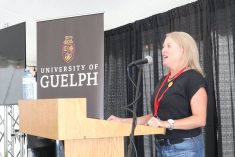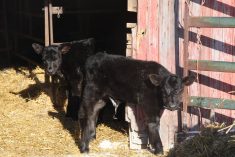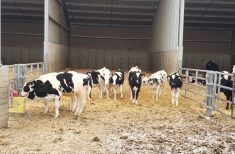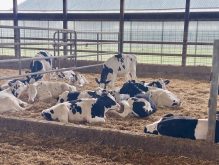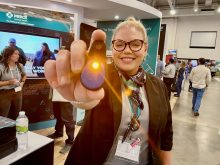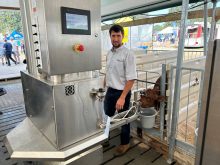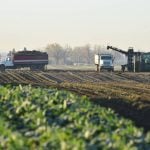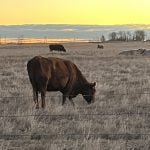The North American dairy breeding sector is providing early-stage advice to protect herds against a newly discovered and potentially fatal genetic defect affecting Holstein calves.
The first official word on the defect, currently referred to as calf recumbency, came through a joint news release on April 3 from the U.S.-based Council on Dairy Cattle Breeding (CDCB), Holstein Association USA, and the National Association of Animal Breeders.
It stated that affected calves are otherwise healthy but unable to stand and, as a result, either die or must be euthanized.
Read Also

Packer buys Green Giant, Le Sieur veg brands from U.S. owner
A Quebec-based processor’s deal to buy the Green Giant and Le Sieur packaged and frozen vegetable brands in Canada from a U.S. owner clarifies the status of two popular retail brands grown by Canadian farmers.
Why it matters: Genetics sector leaders in the U.S. and Canada are urging Holstein breeders to notify them if a calf cannot stand after birth so that tests can be done for the recently discovered defect.
A newborn’s inability to stand has long been associated with either inadequate dam nutrition or trauma during birth. But recent research by Penn State University and the United States Department of Agriculture confirmed that a genetic defect can also cause the condition.
“Considering the animal welfare aspect of this defect, the development of a reliable diagnostic tool is very important to consumers, farmers and the dairy genetics industry,” the joint U.S. news release stated.
The industry acknowledges that this defect must be addressed quickly. The priority is to provide access to accurate diagnostic tools with transparent and wide communication of carrier statuses of affected males and females.”
As of early April, two U.S. labs had gene tests available to determine carrier status and others followed suit in subsequent weeks. By early May, companies serving Canadian breeders with Holstein semen — both U.S.-based and Canadian-based — had announced the availability of “carrier” status information for their bull line-ups.
A May 4 announcement from the Ohio headquarters of Select Sires said the carrier status of its bulls was available on its website.
“As more AI organizations test and report the carrier status of their sires, these results will also be added to the database.
“Holstein breeders should consider testing their most valuable females for this condition,” the Select Sires announcement said. “If females are not tested, making strategic decisions about all matings based on known sire pedigree stacks will provide another level of safeguard.”
Brian Van Doormaal, chief services officer at Lactanet, said the gene test offered by some private labs in the U.S. will soon be part of all genotyping services provided through Holstein Canada, Semex and other businesses offering genomic testing to Canadian farmers. At this time, “there is no need for farmers to work directly with the testing labs (which currently have the test).”
“We are not at the stage yet of quantify the frequency of this undesirable gene in the Canadian Holstein population. To do so, we require results of many animals tested for it and any such testing has just started,” he said, noting there is no reason to expect any significant difference in prevalence rate, higher or lower, in Canadian Holsteins versus the U.S. Holstein population.
Van Doormaal notes that Lactanet works closely with the CDCB in United States, and all information and knowledge about the haplotype will be openly shared. He said the CDCB is also working on developing a haplotype analysis procedure to give reliable results without doing the actual gene test.
“Once that is developed, CDCB will openly share the haplotype results for all genotyped animals with Lactanet.”
This stage would allow essentially all animals to have a Carrier Probability value displayed for Calf Recumbency on the Lactanet website, he said. “I expect this is most likely still a few months away.”
Possible origins
Researchers hope to determine an original defect carrier but the oldest known suspected carrier is the U.S.-owned bull Southwind Bell of Bar-Lee. It’s probable that Southwind inherited the region of DNA now known to become affected by the recumbency defect from Osborndale Ivanhoe, one of the foundation sires of North America’s Holstein gene pool.
But it’s highly unlikely that Ivanhoe carried the mutation.
“It is through Southwind’s most prominent descendants, Robust and Supersire, that the gene has spread throughout the breed,” Semex said in its news release.
The announcement speaks to the complexity that researchers are dealing with when it comes to this defect. The mutation only surfaced recently, so a significant percentage of animals that are homozygous for that particular region of DNA show no symptoms.
Plus, a producer’s ability to pinpoint a calf affected by recumbency is difficult when other conditions can also cause it.
“Identifying a genetic defect with enough certainty for publication is a long process,” the joint U.S. news release noted. “This is especially the case when the phenotypes (observations) are subjective or when calves are euthanized before accurate phenotyping took place.”
The Penn State and USDA research compared the genotypes of 18 post-natal calves that were unable to stand to 26 unaffected calves from the same family groups. All of the affected calves were homozygous — or carried two copies of the affected region of DNA on Chromosome 16. This is now referred to as the haplotype for the defect.
Research teams then traced genotypes of the family trees of the affected calves and determined that “the identified haplotype is common and traces back many generations.”
The high percentage of symptom-free carriers “happens with new mutations because there hasn’t been sufficient time and data to differentiate the mutated haplotype from the original and normal one,” the U.S. news release explains.
“More validation between the data from the available gene tests with the haplotype data must take place to remove uncertainty and increase reliability so the haplotype test can be routinely applied for all genotyped animals.
“We thank all the breeders that have come forward to researchers or industry organizations with observations and samples and we encourage others to do so in the future. … Individual farmer reporting of abnormal calves remains essential.”
The U.S. breeding organizations commended AI companies for working quickly to determine and publish the “free” or “carrier” status of their bulls. But they also advise Holstein breeders using those bulls that, at this early stage, “due to chance in families sampled, some companies will have more carrier animals in their bull and donor cow populations than others.”




